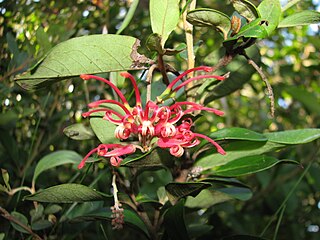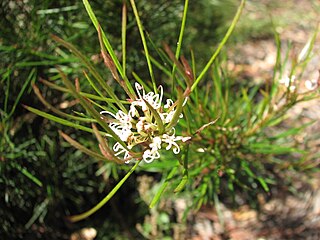Related Research Articles

Alexander Segger George is a Western Australian botanist. He is the authority on the plant genera Banksia and Dryandra. The "bizarre" Restionaceae genus Alexgeorgea was named in his honour in 1976.
James Hamlyn Willis was an Australian botanist. He described 64 new species of plants, and published more than 880 works including the landmark two-volume A Handbook to plants in Victoria between 1962 and 1973.
Australian Biological Resources Study (ABRS) is a project undertaken by Parks Australia Division of Australia's Department of the Environment, Water, Heritage and the Arts (DEWHA).

Flora of Australia is a 59 volume series describing the vascular plants, bryophytes and lichens present in Australia and its external territories. The series is published by the Australian Biological Resources Study who estimate that the series when complete will describe over 20 000 plant species. It was orchestrated by Alison McCusker.

Nancy Tyson Burbidge was an Australian systemic botanist, conservationist and herbarium curator.
Donald John McGillivray in New South Wales, Australia, usually known as D.J. McGillivray, was an Australian botanical taxonomist. He was trained in forestry, and became interested in plant taxonomy just before he transferred in 1964 to the National Herbarium of the Royal Botanic Gardens in Sydney, New South Wales.

The Fungi of Australia form an enormous and phenomenally diverse group, a huge range of freshwater, marine and terrestrial habitats with many ecological roles, for example as saprobes, parasites and mutualistic symbionts of algae, animals and plants, and as agents of biodeterioration. Where plants produce, and animals consume, the fungi recycle, and as such they ensure the sustainability of ecosystems.

Grevillea barklyana, also known as gully grevillea or large-leaf grevillea, is a species of flowering plant in the family Proteaceae and is endemic to Western Gippsland in Victoria, Australia. It is an erect shrub or small tree, with mostly pinnatifid leaves with two to eleven lobes, and whitish pink to fawn flowers.

Grevillea obtecta, commonly known as Fryerstown grevillea, Elphinstone grevillea or Taradale grevillea is a species of flowering plant in the family Proteaceae and is endemic to Victoria in Australia. It is a prostrate, clumping or straggling shrub with pinnatifid, pinnatipartite or toothed leaves, and toothbrush-like clusters of light green to yellowish and purplish to black flowers with a dull yellow to pink style.

Neville Graeme Marchant is a retired Western Australian botanist. He was formerly the Director of the Western Australian Herbarium.

Grevillea miqueliana is a species of flowering plant in the family Proteaceae and is endemic to Victoria in Australia. It is an erect to spreading shrub with elliptic to egg-shaped leaves and clusters of red and orange or yellow flowers.

Grevillea neurophylla, commonly known as granite grevillea, is a species of flowering plant in the family Proteaceae and is endemic to south-eastern continental Australia. It is a spreading to erect shrub with linear leaves, and clusters of white to pale pink flowers with a strongly hooked style.

Grevillea cagiana, commonly known as red toothbrushes, is a species of flowering plant in the family Proteaceae and is endemic to the south-west of Western Australia. It is an erect or spreading shrub with simple or divided leaves with linear lobes, and green, yellow, orange or pink flowers with red styles.
Megahertzia is a monotypic genus of flowering plants in the family Proteaceae. The sole species, Megahertzia amplexicaulis, is endemic to Queensland. It is found only in part of the Wet Tropics World Heritage Area between the Daintree River and Cape Tribulation.

Cyanothamnus anemonifolius, commonly known as narrow-leaved boronia or sticky boronia, is a flowering plant that is endemic to south-eastern Australia. It is a shrub with mostly pinnate leaves, with white to pale pink four-petalled flowers in leaf axils.

Council of Heads of Australasian Herbaria (CHAH) is an association of the leaders of herbaria in Australia and New Zealand. It is governed by a constitution. It endorses the taxonomy and nomenclature of the Australian Plant Census, which is the source for accepted names of species and, in particular, for accepted names of Australasian species. It supports the Australian Plant Name Index. CHAH is incorporated in the A.C.T. and is an Australian registered business with ABN 31 496 409 479.

Dianella longifolia, commonly known as blueberry lily, pale flax lily or smooth flax lily, or blue flax-lily, is a species of flowering plant in the family Asphodelaceae and is endemic to non-arid areas of Australia. It is a tufted, rhizomatous, perennial herb with grass-like leaves, pale blue, white or greenish flowers that have pale yellow anthers, and shiny, pale blue berries.

Isopogon scabriusculus is a species of flowering plant in the family Proteaceae and is endemic to southwestern Western Australia. It is a shrub with cylindrical, or narrow flat, sometimes forked leaves, and spherical to oval heads of pink or red flowers.
Don Foreman was an Australian botanist who worked on the Monimiaceae and Proteaceae of Australia. He also helped with the editing of selected Flora of Victoria and Flora of Australia Volumes.

Grevillea diffusa is a species of flowering plant in the family Proteaceae and is endemic to the Sydney region of New South Wales. It is a low, compact shrub with elliptic to linear leaves, and dark red, or dark crimson to scarlet and burgundy-coloured flowers.
References
- ↑ Australian Botanical Liaison Officer (ABLO), Department of Sustainability, Environment, Water, Population and Communities.